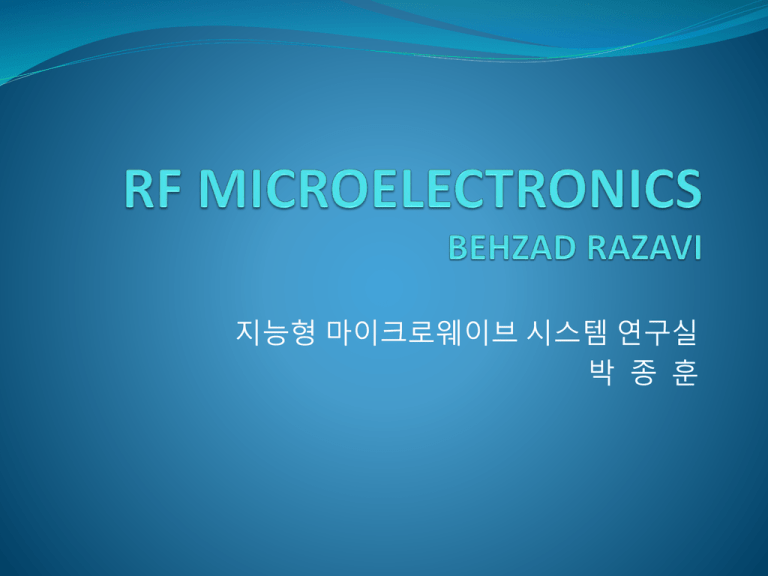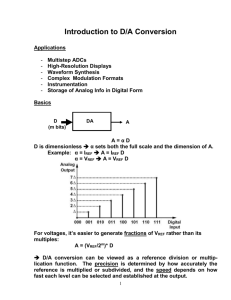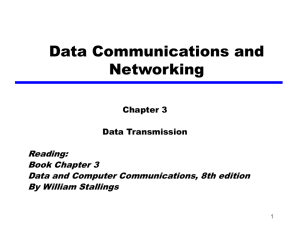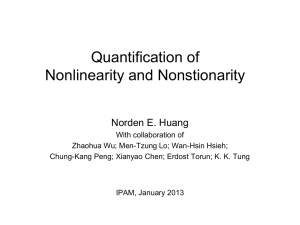RF MICROELECTRONICS BEHZAD RAZAVI
advertisement

지능형 마이크로웨이브 시스템 연구실 박 종 훈 Contents Ch.1 Introduction to RF & Wireless Technology 1.1 Complexity Comparison 1.2 Design Bottleneck 1.3 Applications 1.4 Analog and Digital Systems 1.5 Choice of Technology Ch.2 Basic Concepts in RF Design 2.1 Nonlinearity and Time Variance 2.2 Intersymbol Interference 2.3 Random Processes and Noise 2.4 Sensitivity and Dynamic Range 2.5 Passive Impedance Transformation 1. Introduction to RF & Wireless Technology 1. Telephones have gotten much more complicated. -> RF Circuits 2. Guglielmo Marconi Successfully transmitted radio signals across the Atlantic Ocean in 1901. -> Wireless technology 1.1 Complexity Comparison 1.2 Design Bottleneck 1.3 Applications 1.4 Analog and Digital Systems 1. Introduction to RF & Wireless Technology 3. Invention of the transistor Development the conception of the cellular system Car phone -> Cellular phone 4. Motivating competitive manufacturers to provide phone sets Higher performance and lower cost Present goal – reduce power consumption and price by 30% every year 5. Future (wrote in 1998) GPS(Global Positioning System) PCS( Personal Communication Services) 1.1 Complexity Comparison 1.2 Design Bottleneck 1. Multidisciplinary Field RF Design Communication Theory, Microwave Theory, Signal Propagation, Multiple Access, Wireless Standards, CAD Tools, IC Design, Transceiver Architectures, Random Signals 1.2 Design Bottleneck 2. RF Design Hexagon Trade Off 3. Design Tools SPICE – Linear and Time invariant models RF circuits – Nonlinearity, Time variance, Noise 1.3 Applications 1. WLAN(Wireless Local Area Network) 900Mhz, 2.4Ghz 2. GPS 1.5Ghz range 3. RF IDs(RF Identification Systems) 900Mhz, 2.4Ghz 4. Home Satellite Network 10Ghz 1.4 Analog and Digital Systems 1. Analog System 1.4 Analog and Digital Systems 2. Digital System Signal Processing Analog < Digital 1.5 Choice of Technology 1. GaAs, Silicon Bipolar, BiCMOS Low-yield, high-power, high-cost option Heterojunction devices PA, front-end switches 2. VLSI High-quality inductors and capacitors Higher levels of integtation Lower overall cost 3. CMOS High transit frequency Substrate coupling, parameter variation, etc. Ch.2 Basic Concepts in RF Design 2.1 Nonlinearity and Time Variance 2.2 Intersymbol Interference 2.3 Random Processes and Noise 2.4 Sensitivity and Dynamic Range 2.5 Passive Impedance Transformation 2.1 Nonlinearity and Time Variance If input x1(t) and x2(t) x1(t) -> y1(t), x2(t) -> y2(t), ax1(t) + bx2(t) -> ay1(t) + by2(t) Not satisfy -> Nonlinear x(t) -> y(t), x(t-τ) -> y(t- τ) Not satisfy -> Time variant 2.1 Nonlinearity and Time Variance 1. Effects of Nonlinearity 1) Harmonics 2.1 Nonlinearity and Time Variance 2) Gain Compression 1dB compression point Input signal level that causes the small-signal gain to drop by 1dB If α3 < 0 , gain is decreasing function of A 2.1 Nonlinearity and Time Variance 3) Desensitization and Blocking Desensitization Since a large signal tends to reduce the average gain of the circuit, the weak signal may experience a vanishingly small gain. Blocking Gain drop to Zero ( α3 < 0 ) A1 << A2 2.1 Nonlinearity and Time Variance 4) Cross Modulation 5) Intermodulation When two signals with different frequencies are applied to a nonlinear system, the output in general exhibits some components that are not harmonics of the input frequencies. 2.1 Nonlinearity and Time Variance Third Intercept Point(IP3) If the difference between w1 and w2 is small, the components at 2w1-w2 and 2w2-w1 appear in the vicinity of w1 and w2 2.2 Intersymbol Interference Linear time-invariant systems can also distort a signal if they do not have sufficient bandwidth Each bit level is corrupted by decaying tails created by previous bits Solution Pulse shaping(Nyquist signaling) Raised cosine 2.2 Intersymbol Interference Pulse Shaping The shape is selected such that ISI is zero at certain points in time 2.2 Intersymbol Interference Raised Cosine α : roll off factor 2.3 Random Processes and Noise 1. Random Processes A family of time functions 1) Statiscal Ensembles Doubly infinite(infinite measurements X infinite time) Time average (n(t) : noise voltage) Ensemble average(Pn(n) : PDF) 2.3 Random Processes and Noise Second-order average(mean square) 2.3 Random Processes and Noise 2) PDF(Probability Density Function) Px(x)dx = probability of x < X < x+dx X is the measured value of x(t) at some point in time Gaussian distribution PDF of the sum approaches a Gaussian distribution 2.3 Random Processes and Noise 3) PSD(Power Spectral Density) 2.3 Random Processes and Noise 2. Noise 1) Thermal Noise resistor base and emitter resistance of bipolar devices channel resistance of MOSFETs 2) Input-Referred Noise 2.3 Random Processes and Noise 3) Noise Figure SNR - Analog circuits NF – RF circuits Consider noise of the circuit & SNR of the pre-stage 2.4 Sensitivity and Dynamic Range 1. Sensitivity Minimum signal level that the system can detect with acceptable SNR. Pin.min = -174dBm/Hz + NF + 10logB + SNRmin Noise floor : -174dBm/Hz + NF + 10logB 2.4 Sensitivity and Dynamic Range 2. Dynamic Range Ratio of the maximum input level that the circuit can tolerate to the minimum input level at which the circuit provides a resonable signal quality. SFDR(Spurious-Free Dynamic Range) Upper end of the dynamic range on the intermodulation behavior Lower end on the sensitivity F : Noise floor 2.5 Passive Impedance Transformation Q of the series combination : 1/RsCsw Q of the parallel combination : RpCpw If Q is relatively high and the band of interest relatively narrow, then one network can be converted to the other 2.5 Passive Impedance Transformation










